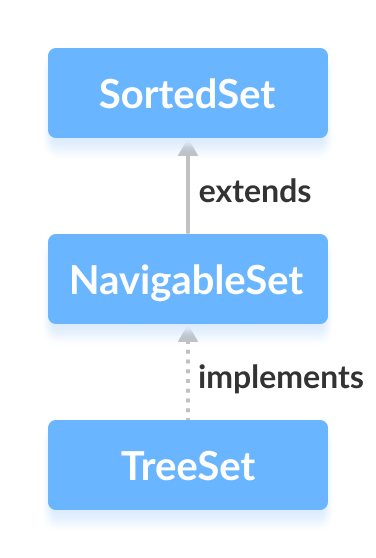The NavigableSet interface of the Java Collections framework provides the features to navigate among the set elements.
It is considered as a type of SortedSet.
Class that implements NavigableSet
In order to use the functionalities of the NavigableSet interface, we need to use the TreeSet class that implements NavigableSet.

How to use NavigableSet?
In Java, we must import the java.util.NavigableSet package to use NavigableSet. Once we import the package, here's how we can create navigable sets.
// SortedSet implementation by TreeSet class
NavigableSet<String> numbers = new TreeSet<>();
Here, we have created a navigable set named numbers of the TreeSet class.
Methods of NavigableSet
The NavigableSet is considered as a type of SortedSet. It is because NavigableSet extends the SortedSet interface.
Hence, all SortedSet methods are also available in NavigableSet. To learn how these methods, visit Java SortedSet.
However, some of the methods of SortedSet (headSet(), tailSet() and subSet()) are defined differently in NavigableSet.
Let's see how these methods are defined in NavigableSet.
headSet(element, booleanValue)
The headSet() method returns all the elements of a navigable set before the specified element (which is passed as an argument).
The booleanValue parameter is optional. Its default value is false.
If true is passed as a booleanValue, the method returns all the elements before the specified element including the specified element.
tailSet(element, booleanValue)
The tailSet() method returns all the elements of a navigable set after the specified element (which is passed as an argument) including the specified element.
The booleanValue parameter is optional. Its default value is true.
If false is passed as a booleanValue, the method returns all the elements after the specified element without including the specified element.
subSet(e1, bv1, e2, bv2)
The subSet() method returns all the elements between e1 and e2 including e1.
The bv1 and bv2 are optional parameters. The default value of bv1 is true, and the default value of bv2 is false.
If false is passed as bv1, the method returns all the elements between e1 and e2 without including e1.
If true is passed as bv2, the method returns all the elements between e1 and e2, including e1.
Methods for Navigation
The NavigableSet provides various methods that can be used to navigate over its elements.
- descendingSet() - reverses the order of elements in a set
- descendingIterator() - returns an iterator that can be used to iterate over a set in reverse order
- ceiling() - returns the lowest element among those elements that are greater than or equal to the specified element
- floor() - returns the greatest element among those elements that are less than or equal to the specified element
- higher() - returns the lowest element among those elements that are greater than the specified element
- lower() - returns the greatest element among those elements that are less than the specified element
- pollFirst() - returns and removes the first element from the set
- pollLast() - returns and removes the last element from the set
To learn more about the NavigableSet, visit Java NavigableSet (official Java documentation).
Implementation of NavigableSet in TreeSet Class
import java.util.NavigableSet;
import java.util.TreeSet;
class Main {
public static void main(String[] args) {
// Creating NavigableSet using the TreeSet
NavigableSet<Integer> numbers = new TreeSet<>();
// Insert elements to the set
numbers.add(1);
numbers.add(2);
numbers.add(3);
System.out.println("NavigableSet: " + numbers);
// Access the first element
int firstElement = numbers.first();
System.out.println("First Number: " + firstElement);
// Access the last element
int lastElement = numbers.last();
System.out.println("Last Element: " + lastElement);
// Remove the first element
int number1 = numbers.pollFirst();
System.out.println("Removed First Element: " + number1);
// Remove the last element
int number2 = numbers.pollLast();
System.out.println("Removed Last Element: " + number2);
}
}
Output
NavigableSet: [1, 2, 3] First Element: 1 Last Element: 3 Removed First Element: 1 Removed Last Element: 3
Now that we know about the NavigableSet interface, we will learn about its implementation using the TreeSet class.
To learn more about TreeSet, visit Java TreeSet.
Also Read: